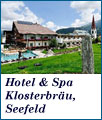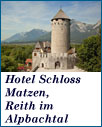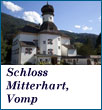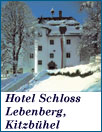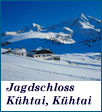Castle Hotels of Tyrol and Vorarlberg
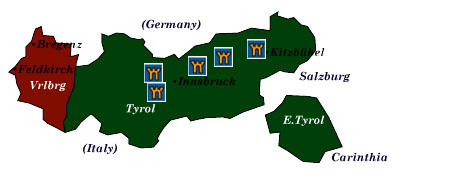
![]() Hotel Schloss Lebenberg
Hotel Schloss Lebenberg
![]() Hotel Schloss Matzen
Hotel Schloss Matzen
![]() Hotel & Spa Klosterbräu
Hotel & Spa Klosterbräu
![]() Schloss Mitterhart
Schloss Mitterhart
![]() Jagdschloss Kühtai
Jagdschloss Kühtai
Haven’t decided on a hotel yet? You can look at other available hotels in the regions of Tyrol and Vorarlberg with Booking.com.
The physical magnificence of Tyrol attracts visitors who come by the millions every year to revel on snowcapped mountains that seem to stretch across the universe, hike beside rushing streams that cascade into winding Alpine valleys, and simply wander through a forest straight out of Bambi.
Winter is the season to be seen on the slopes and in the resort villages, but the warmer months wield magic as well for those who love clear mountain air and quiet inspiration.
After World War I, the southern part of Tyrol was awarded to Italy. What is now East Tyrol is geographically separated by towering mountain ranges from the main region of Tyrol and is home to the Hohe Tauern National Park; it orients itself more toward Carinthia than to Tyrol.
Vorarlberg remains culturally separate from mainstream Austria by linguistic and historic connections to neighboring Switzerland, Liechtenstein, and Germany. In 1918, Vorarlberg sought political union with Switzerland, an idea defeated at a postwar peace conference. Vorarlberg’s attractions range from the enchanting Bregenzerwald—an area of lush forests dotted by traditional villages—to Lech, one of Europe’s most chic ski resorts.
Go to a Different Region
Carinthia
Salzburg
Styria and Burgenland
Upper and Lower Austria
Vienna
Some great reasons to visit
![]() Spectacular alpine scenery To experience the real charm of the region, it’s worthwhile to explore the many hidden valleys dotted with fairy tale villages and an occasional hillside castle. The Ötztal Valley is a good place to start.
Spectacular alpine scenery To experience the real charm of the region, it’s worthwhile to explore the many hidden valleys dotted with fairy tale villages and an occasional hillside castle. The Ötztal Valley is a good place to start.
![]() World-class skiing Wherever you go in western Austria, you’ll find a ski run on the nearest mountainside. Innsbruck, Seefeld, Kitzbühel, St Anton, and Lech may be the most famous ski resort areas, but smaller ones with more reasonable prices exist everywhere.
World-class skiing Wherever you go in western Austria, you’ll find a ski run on the nearest mountainside. Innsbruck, Seefeld, Kitzbühel, St Anton, and Lech may be the most famous ski resort areas, but smaller ones with more reasonable prices exist everywhere.
![]() Innsbruck Known to the world as host of two Winter Olympic Games in 1964 and 1976, Innsbruck has been the center of attention in the Tyrol since its origins as a medieval trading settlement. Emperor Maximilian I held court here in 1493, designing many of the monuments you see, including his mausoleum, the Hofkirche. The Hofburg is a Rococo style palace built for Empress Maria Theresa, who held court here as well. An exceptional Renaissance palace in the area open to visitors is Schloss Ambras.
Innsbruck Known to the world as host of two Winter Olympic Games in 1964 and 1976, Innsbruck has been the center of attention in the Tyrol since its origins as a medieval trading settlement. Emperor Maximilian I held court here in 1493, designing many of the monuments you see, including his mausoleum, the Hofkirche. The Hofburg is a Rococo style palace built for Empress Maria Theresa, who held court here as well. An exceptional Renaissance palace in the area open to visitors is Schloss Ambras.
![]() Kitzbühel Famed for its superb skiing and sports facilities, annual downhill ski race (Hahnenkamm), and excellent hiking trails, Kitzbühel also offers historic churches, a charming pedestrian-only center, and, during the late spring and summer months, an alpine flower reserve.
Kitzbühel Famed for its superb skiing and sports facilities, annual downhill ski race (Hahnenkamm), and excellent hiking trails, Kitzbühel also offers historic churches, a charming pedestrian-only center, and, during the late spring and summer months, an alpine flower reserve.
![]() Hohe Tauern National Park This spectacular national park—encompassing territory in three of Austria’s provinces: Tyrol, Salzburg, and Carinthia—is one of the largest areas in which to see Europe in the “wild.” The park includes Austria’s highest peak (the Grossglockner), the longest glacier in the eastern Alps (the Pasterze Glacier), and the tallest waterfall (Krimml Falls), as well as more than 300 peaks over 3000 m. (9850 ft.) in height. Don’t miss a drive over the famous Grossglockner Hochalpenstrasse (high alpine road), considered one of the most beautiful mountain roads in the world.
Hohe Tauern National Park This spectacular national park—encompassing territory in three of Austria’s provinces: Tyrol, Salzburg, and Carinthia—is one of the largest areas in which to see Europe in the “wild.” The park includes Austria’s highest peak (the Grossglockner), the longest glacier in the eastern Alps (the Pasterze Glacier), and the tallest waterfall (Krimml Falls), as well as more than 300 peaks over 3000 m. (9850 ft.) in height. Don’t miss a drive over the famous Grossglockner Hochalpenstrasse (high alpine road), considered one of the most beautiful mountain roads in the world.
![]() Bregenz The pleasant provincial capital of Vorarlberg sits on the southeastern shore of one of Europe’s most famous lakes, the Bodensee (Lake Constance). Boat trips around the lake, visiting Germany and Switzerland, are a popular activity, as well as day excursions to the Bregenzerwald (Bregenz forest). In summer, the Bregenz Music Festival, with its specially constructed floating stage, attracts concert lovers from all over Europe.
Bregenz The pleasant provincial capital of Vorarlberg sits on the southeastern shore of one of Europe’s most famous lakes, the Bodensee (Lake Constance). Boat trips around the lake, visiting Germany and Switzerland, are a popular activity, as well as day excursions to the Bregenzerwald (Bregenz forest). In summer, the Bregenz Music Festival, with its specially constructed floating stage, attracts concert lovers from all over Europe.
![]() Bludenz The International Milk Chocolate Festival is held here every July. Who can resist!
Bludenz The International Milk Chocolate Festival is held here every July. Who can resist!
